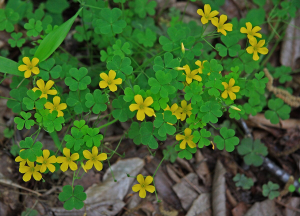 A common weed in gardens and potted plants, yellow woodsorrel is native to North America and is known throughout continental United States. It is an herbaceous perennial that prefers full to partial sun, and rich, moist to slight dry soil, but tolerates much less. Gardens and lawns are especially to its liking but the edges of paths and driveways are also favored sites. Yellow woodsorrel is edible and has a slightly sour taste but should be avoided by people with gout, kidney problems, and rheumatoid arthritis because of its high potassium oxalate and oxalic acid content. Photo Credit: Dcrjsr Wikipedia
A common weed in gardens and potted plants, yellow woodsorrel is native to North America and is known throughout continental United States. It is an herbaceous perennial that prefers full to partial sun, and rich, moist to slight dry soil, but tolerates much less. Gardens and lawns are especially to its liking but the edges of paths and driveways are also favored sites. Yellow woodsorrel is edible and has a slightly sour taste but should be avoided by people with gout, kidney problems, and rheumatoid arthritis because of its high potassium oxalate and oxalic acid content. Photo Credit: Dcrjsr Wikipedia
 Description: Thin, weak, green to pink stems branching from the base are erect at first, up to 20” tall, but often flop down as they mature. The green leaves may be tinged with red and are divided into three leaflets each of which is heart shaped with a prominent crease that allows them to fold up at night. From spring to fall the plant produces clusters of yellow flowers about ½” across with 5 petals. The flowers are followed by seed pods ¾” long, called capsules. When the capsules are ripe they explosively shoot the seeds up to 13’ away when disturbed. Yellow woodsorrel has a fibrous root system with long slender rhizomes.
Description: Thin, weak, green to pink stems branching from the base are erect at first, up to 20” tall, but often flop down as they mature. The green leaves may be tinged with red and are divided into three leaflets each of which is heart shaped with a prominent crease that allows them to fold up at night. From spring to fall the plant produces clusters of yellow flowers about ½” across with 5 petals. The flowers are followed by seed pods ¾” long, called capsules. When the capsules are ripe they explosively shoot the seeds up to 13’ away when disturbed. Yellow woodsorrel has a fibrous root system with long slender rhizomes.

 Control: Yellow woodsorrel is best controlled by hand pulling and eliminating plants before they set seed. Preemergent herbicides applied in spring control woodsorrel but since they work by inhibiting seed germination they may hamper the germination of desirable seeds. A broadleaf herbicide such as 2,4 D is effective against woodsorrel growing in a lawn if applied when in active growth.
Control: Yellow woodsorrel is best controlled by hand pulling and eliminating plants before they set seed. Preemergent herbicides applied in spring control woodsorrel but since they work by inhibiting seed germination they may hamper the germination of desirable seeds. A broadleaf herbicide such as 2,4 D is effective against woodsorrel growing in a lawn if applied when in active growth.